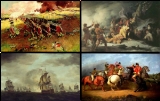
and thirteen British colonies
in North America
, and ended in a global war between several European great power
s.
The war was the result of the political American Revolution
. Colonists galvanized around the position that the Stamp Act of 1765
, imposed by Parliament of Great Britain
, was unconstitutional. The British Parliament insisted it had the right to tax colonists.
1765 American Revolutionary War: The Kingdom of Great Britain passes the Quartering Act that requires the Thirteen Colonies to house British troops.
1772 American Revolutionary War: Samuel Adams and Joseph Warren form the first Committee of Correspondence.
1773 Just before the beginning of the American Revolutionary War, several of the British East India Company's tea ships are set ablaze at the old seaport of Annapolis, Maryland.
1774 American Revolutionary War: The Kingdom of Great Britain orders the port of Boston, Massachusetts closed pursuant to the Boston Port Act.
1775 American Revolutionary War: The British Parliament declares Massachusetts in rebellion.
1775 American Revolutionary War: Patrick Henry delivers his speech – "Give me Liberty, or give me Death!" – at St. John's Church in Richmond, Virginia.
1775 American Revolutionary War: The war begins with the battles of Lexington and Concord.
1775 American Revolutionary War: the Siege of Boston begins, following the battles at Lexington and Concord.
1775 American Revolutionary War: Fort Ticonderoga is captured by a small Colonial militia led by Ethan Allen and Colonel Benedict Arnold.
1775 American Revolutionary War: the Continental Congress bans trade with Canada.

